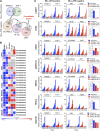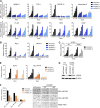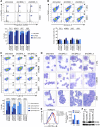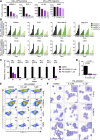Requirement for CDK6 in MLL-rearranged acute myeloid leukemia
- PMID: 24764564
- PMCID: PMC4190617
- DOI: 10.1182/blood-2014-02-558114
Requirement for CDK6 in MLL-rearranged acute myeloid leukemia
Abstract
Chromosomal rearrangements involving the H3K4 methyltransferase mixed-lineage leukemia (MLL) trigger aberrant gene expression in hematopoietic progenitors and give rise to an aggressive subtype of acute myeloid leukemia (AML). Insights into MLL fusion-mediated leukemogenesis have not yet translated into better therapies because MLL is difficult to target directly, and the identity of the genes downstream of MLL whose altered transcription mediates leukemic transformation are poorly annotated. We used a functional genetic approach to uncover that AML cells driven by MLL-AF9 are exceptionally reliant on the cell-cycle regulator CDK6, but not its functional homolog CDK4, and that the preferential growth inhibition induced by CDK6 depletion is mediated through enhanced myeloid differentiation. CDK6 essentiality is also evident in AML cells harboring alternate MLL fusions and a mouse model of MLL-AF9-driven leukemia and can be ascribed to transcriptional activation of CDK6 by mutant MLL. Importantly, the context-dependent effects of lowering CDK6 expression are closely phenocopied by a small-molecule CDK6 inhibitor currently in clinical development. These data identify CDK6 as critical effector of MLL fusions in leukemogenesis that might be targeted to overcome the differentiation block associated with MLL-rearranged AML, and underscore that cell-cycle regulators may have distinct, noncanonical, and nonredundant functions in different contexts.
© 2014 by The American Society of Hematology.
Figures






Comment in
-
CDK6, a new target in MLL-driven leukemia.Blood. 2014 Jul 3;124(1):5-6. doi: 10.1182/blood-2014-05-572917. Blood. 2014. PMID: 24993876
Similar articles
-
Bortezomib suppresses self-renewal and leukemogenesis of leukemia stem cell by NF-ĸB-dependent inhibition of CDK6 in MLL-rearranged myeloid leukemia.J Cell Mol Med. 2021 Mar;25(6):3124-3135. doi: 10.1111/jcmm.16377. Epub 2021 Feb 17. J Cell Mol Med. 2021. PMID: 33599085 Free PMC article.
-
CDK6, a new target in MLL-driven leukemia.Blood. 2014 Jul 3;124(1):5-6. doi: 10.1182/blood-2014-05-572917. Blood. 2014. PMID: 24993876
-
MLL fusion-driven activation of CDK6 potentiates proliferation in MLL-rearranged infant ALL.Cell Cycle. 2014;13(5):834-44. doi: 10.4161/cc.27757. Cell Cycle. 2014. PMID: 24736461 Free PMC article.
-
Learning from mouse models of MLL fusion gene-driven acute leukemia.Biochim Biophys Acta Gene Regul Mech. 2020 Aug;1863(8):194550. doi: 10.1016/j.bbagrm.2020.194550. Epub 2020 Apr 19. Biochim Biophys Acta Gene Regul Mech. 2020. PMID: 32320749 Review.
-
Molecular mechanisms of MLL-associated leukemia.Int J Hematol. 2015 Apr;101(4):352-61. doi: 10.1007/s12185-015-1774-4. Epub 2015 Mar 17. Int J Hematol. 2015. PMID: 25773519 Review.
Cited by
-
TBP loading by AF4 through SL1 is the major rate-limiting step in MLL fusion-dependent transcription.Cell Cycle. 2016 Oct 17;15(20):2712-22. doi: 10.1080/15384101.2016.1222337. Epub 2016 Aug 26. Cell Cycle. 2016. PMID: 27564129 Free PMC article.
-
The IRX1/HOXA connection: insights into a novel t(4;11)- specific cancer mechanism.Oncotarget. 2016 Jun 7;7(23):35341-52. doi: 10.18632/oncotarget.9241. Oncotarget. 2016. PMID: 27175594 Free PMC article.
-
Computer simulations of the signalling network in FLT3 +-acute myeloid leukaemia - indications for an optimal dosage of inhibitors against FLT3 and CDK6.BMC Bioinformatics. 2018 Apr 24;19(1):155. doi: 10.1186/s12859-018-2145-y. BMC Bioinformatics. 2018. PMID: 29699481 Free PMC article.
-
Palbociclib in Acute Leukemias With KMT2A-rearrangement: Results of AMLSG 23-14 Trial.Hemasphere. 2023 Apr 21;7(5):e877. doi: 10.1097/HS9.0000000000000877. eCollection 2023 May. Hemasphere. 2023. PMID: 37101762 Free PMC article. No abstract available.
-
ZNF521 sustains the differentiation block in MLL-rearranged acute myeloid leukemia.Oncotarget. 2017 Apr 18;8(16):26129-26141. doi: 10.18632/oncotarget.15387. Oncotarget. 2017. PMID: 28412727 Free PMC article.
References
-
- Döhner H, Estey EH, Amadori S, et al. European LeukemiaNet. Diagnosis and management of acute myeloid leukemia in adults: recommendations from an international expert panel, on behalf of the European LeukemiaNet. Blood. 2010;115(3):453–474. - PubMed
-
- Grimwade D, Hills RK, Moorman AV, et al. National Cancer Research Institute Adult Leukaemia Working Group. Refinement of cytogenetic classification in acute myeloid leukemia: determination of prognostic significance of rare recurring chromosomal abnormalities among 5876 younger adult patients treated in the United Kingdom Medical Research Council trials. Blood. 2010;116(3):354–365. - PubMed
-
- Krauter J, Wagner K, Schäfer I, et al. Prognostic factors in adult patients up to 60 years old with acute myeloid leukemia and translocations of chromosome band 11q23: individual patient data-based meta-analysis of the German Acute Myeloid Leukemia Intergroup. J Clin Oncol. 2009;27(18):3000–3006. - PubMed
-
- Krivtsov AV, Twomey D, Feng Z, et al. Transformation from committed progenitor to leukaemia stem cell initiated by MLL-AF9. Nature. 2006;442(7104):818–822. - PubMed
Publication types
MeSH terms
Substances
Grants and funding
LinkOut - more resources
Full Text Sources
Other Literature Sources
Medical
Molecular Biology Databases

